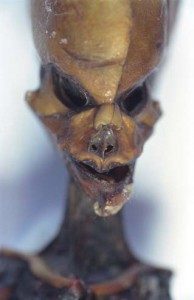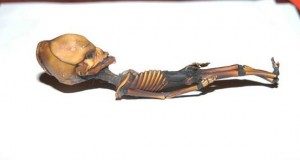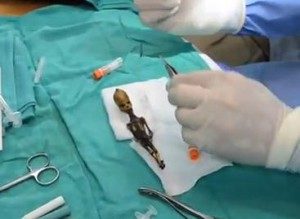 Hot off the presses, Dr. Greer announces the release of his preliminary report on the analysis of the Atacama Humanoid!
Hot off the presses, Dr. Greer announces the release of his preliminary report on the analysis of the Atacama Humanoid!
Making headlines in the paranormal and scientific community alike over the last few weeks, the Disclosure Project, headed by Dr Steven M. Greer MD has been hyping up their planned release of the Sirius UFO “documentary” on April 24, 2013. Apparently in that effort, Greer has today released a special preliminary report on the analysis of the Atacama Humanoid, said to be the focal point of the documentary.
UFO and paranormal enthusiast have been going nuts with anticipation for information on this little whatever-it-is. As the story goes, a six-inch long humanoid figure, highly desiccated but preserved in mummy-like fashion, was found in the wilds of the Atacama desert of Chile in 2003. Greer became aware of the figure in 2009 when he was invited to examine the remains. Then in 2012 Ramón Navia-Osorio Villar, President of the Instituto De Investigaciones Y Estudios Exobiologicos allowed Greer and his team to take x-ray, CAT scans and biological samples from the remains for analysis.
 Photos of the figure are included in the report along with comparisons to fetal skeletal structures and the like. Looking at the photos, which have been available online for some time, one is struck by the look of the creature. It appears almost sculpted, which brings up some doubt that it isn’t an elaborate hoax.
Photos of the figure are included in the report along with comparisons to fetal skeletal structures and the like. Looking at the photos, which have been available online for some time, one is struck by the look of the creature. It appears almost sculpted, which brings up some doubt that it isn’t an elaborate hoax.
In the report Greer identifies Dr. Garry Nolan as the lead expert to have examined and analysed the samples. Nolan, the Rachford and Carlota A. Harris Professor in the Department of Microbiology and Immunology at Stanford University School of Medicine, is quoted in the report discussing his untested conclusion that the creature is definitely a biological entity (apparently not hoaxed) and is not the result of any known skeletal dysplasia or other deformity (including anencephaly).
The report goes on to describe, briefly, the protocols used to identify and process the DNA of apparent bone marrow samples taken from the creatures rib (of which it apparently has 10, which is not consistent with known hominids). Some scientific terminology is used throughout the report,  lending some small measure of credibility to the story, but as Nolan points out late in the report, these are preliminary findings that have yet to be confirmed through peer review, which will reportedly take place in roughly a year.
lending some small measure of credibility to the story, but as Nolan points out late in the report, these are preliminary findings that have yet to be confirmed through peer review, which will reportedly take place in roughly a year.
Greer is careful not to draw premature conclusions based on the data provided by Nolan and others, but he does offer some speculation about other specimens that may exist in and around Chile, and even the possibility that there are living examples of this creature in the Atacama Desert. Greer asks several questions in the “Hypothesis and Thoughts” section at the end of the report, and he seems to suggest that this creature is not of extraterrestrial nature.
It is clear that more analysis is required, but the tantalising nature of the report holds parallels to the Ketchum-Bigfoot debacle of late 2012 early 2013. Is this the future of scientific reporting where controversial topics are concerned? Is hype for the story more important than scientific credibility?

Greer is a medical doctor, having received his medical license (Virginia) from the University of North Carolina. In 1990 he founded the Center for the Study of Extraterrestrial Intelligence (CSETI) and then The Disclosure Project in 1993, eventually giving up his career as an emergency room physician in 1998 to pursue government disclosure of alien contact on Earth. He has appeared on multiple television programs dealing with the extraterrestrial question, including Larry King Live, and is an outspoken member of the UFOlogical community.
Greer enjoys a good deal of credibility in both the paranormal and scientific community, and the Sirius documentary is said to contain life-altering information, but have his efforts now been mired by the premature release of information that should have been published traditionally, in a peer-reviewed scientific journal?
As mentioned, the preliminary report says, explicitly, that there are yet no answers regarding the identity or origin of the creature and that the results of their six-month long study are due to be published in the future, but this is all too familiar and makes one hesitant to accept that his speculations are anything more than the fantasies of a man who’s passion for the topic at hand is heightened, to say the least.
With the release of the film only days away, the world will finally see what all the fuss is about, and if this preliminary report is any indication, we might all be disappointed by a lack of concrete information.
The preliminary report can be found here: Stanford University Research: Atacama Humanoid Still A Mystery
